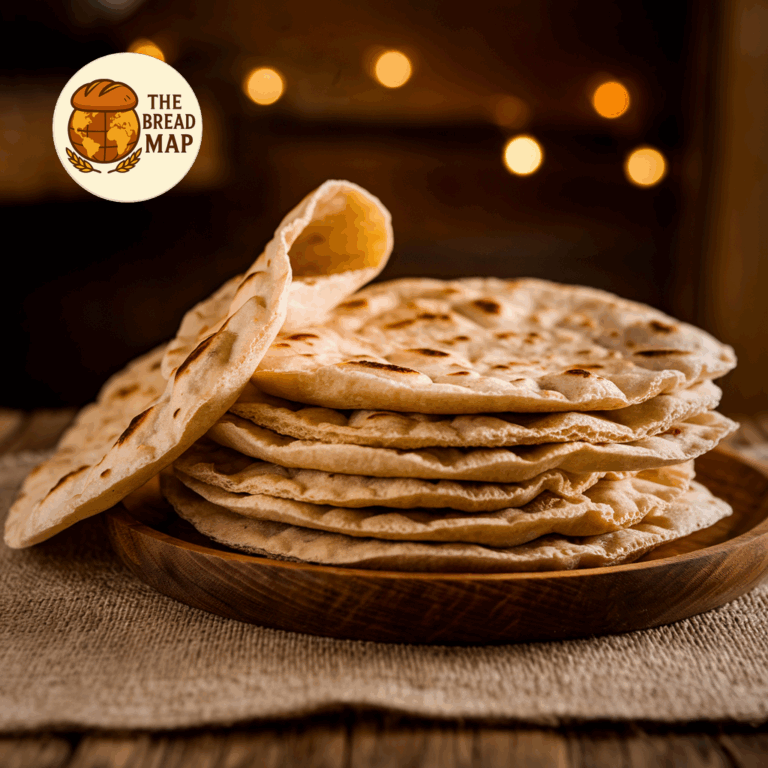
Some breads are merely sides — others, like Taftoon, are an invitation into a culture’s kitchen. This beloved Iranian flatbread walks the line between softness and chew, with just the right charred edges and the buttery fragrance of saffron carried from oven to table. Let’s explore Taftoon’s fragrant heart, where tradition, heat, and flour collide.
Introduction
Taftoon (also spelled Taftan) is more than a flatbread — it’s a warm extension of Iranian hospitality. Baked in searingly hot tandoor-style clay ovens, its puffed, golden surface reveals a life spent in high heat and high regard. Its versatility makes it just as at home wrapped around grilled kebabs as it is dipped into creamy yogurt or spread with homemade jam for breakfast.
Historical Background
Flatbreads have long been a cornerstone of Iranian cuisine, with evidence of their presence dating back to ancient Persia. Taftoon, in particular, likely emerged from nomadic and urban baking traditions that prized breads which could both accompany meals and stand on their own. While Lavash offered a thin, crisp form and Barbari delivered a thicker, chewy experience, Taftoon landed somewhere beautifully in between — soft, slightly sweet, and scented with subtle aromatics like cardamom or saffron.
Historically, it was a bread favored in royal Persian courts for its enriched dough and delicate flavor, often served with tea, dates, or subtly spiced stews.
Region of Origin
Though enjoyed nationwide in Iran, Taftoon is believed to have originated in the central regions, particularly in areas with access to traditional clay ovens. Over time, cities like Yazd and Isfahan evolved unique versions of the bread, sometimes introducing local twists like milk-glazing or poppy seed sprinkling. The word “Taftoon” itself is thought to come from the Persian word “taftan,” meaning to heat or burn — a nod to the fiery temperatures of the clay oven.
Ingredients and Preparation
Taftoon’s magic comes from its simplicity, elevated by subtle enrichments that separate it from everyday flatbreads.
- Flour – Typically all-purpose or a mix of white and whole wheat.
- Yeast – Gives the bread a light, airy lift.
- Milk – An optional enrichment for softness and flavor.
- Butter or Oil – To achieve that tender crumb.
- Sugar – Often added for a hint of sweetness.
- Salt – For balance.
- Cardamom or Saffron – For a whisper of Persian aromatic splendor.
- Poppy seeds – Occasionally sprinkled for flavor and presentation.
The dough is kneaded and left to rise before being rolled into rounds or ovals. Right before baking, it’s often brushed with milk or infused saffron water for extra color and aroma. The baking itself is traditionally done on the walls of a clay tandoor, where the high heat quickly puffs and chars the bread, creating its signature pillowy bubbles and smoky spots.
Cultural Importance
In Iran, Taftoon is more than a culinary staple — it’s a cultural thread that ties breakfasts, family dinners, and religious feasts together. You’ll find it on the breakfast table with fresh herbs, cheese, walnuts, and sour cherry jam, or alongside hearty Khoresh stews and skewered kebabs during large family meals. It is also common at Nowruz (Persian New Year) celebrations and other festive gatherings, where freshly baked breads symbolize abundance and hospitality.
Many Iranians still seek out traditional bakeries that produce Taftoon fresh daily, respecting the craftsmanship of those who can tease flavor and softness from such humble ingredients. The bread speaks of home-cooked warmth, fragrant kitchens, and generational recipes — quietly delicious and deeply meaningful.
Whether spread with a pat of creamy labneh or used to mop up the last of a saffron-laced stew, Taftoon is not just bread — it’s a bite of Persian heritage.
Leave a Reply